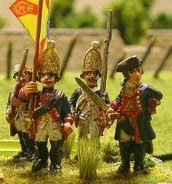 My friend Dave was a member of the New England Wargamers Association (NEWA) back 'in the day'. He and a bunch of his friends gather occasionally to play Column, Line and Square (CLS), a set of Napoleonic rules they played heavily back in the 70s and 80s when NEWA was THE wargaming club in New England. Being slightly younger than Dave's NEWA friends, I was nonetheless invited to participate in Dave's most recent game. The figures, all 25mm, from several nations made up the hypothetical scenario. Both the terrain and the figures were stunning.
My friend Dave was a member of the New England Wargamers Association (NEWA) back 'in the day'. He and a bunch of his friends gather occasionally to play Column, Line and Square (CLS), a set of Napoleonic rules they played heavily back in the 70s and 80s when NEWA was THE wargaming club in New England. Being slightly younger than Dave's NEWA friends, I was nonetheless invited to participate in Dave's most recent game. The figures, all 25mm, from several nations made up the hypothetical scenario. Both the terrain and the figures were stunning.Column, Line and Square is typical of rule sets of its era. There are the various charts based on formation, troop type and nationality. You roll dice, modified by factors for every so many figures if skirmishing, or roll dice then multiply by the figures if in line. There are morale checks with math that nearly requires a calculator, and melees that last for many rounds of dice-offs until one side rolls doubles forcing the other to check morale. It's BLOODY. Units committed to combat, either ranged or melee are rendered useless no matter who wins. This has its charm, especially if you like painting figures, as you can have hundreds on the table and it's a good bet that most of them will get to die during the game.
The player's handbook called the 'Battle Manual', which is the condensed version of the rules, is a svelte 107 pages long, although the full rulebook with all errata is much thicker, around 250+ pages. Needless to say I was not going to be able to familiarize myself with the rules sufficiently before the game as I usually prefer. Instead I would show up and hope luck and tactics alone would save the day for me. Alas, it was not to be so. Buried somewhere in the 250+ pages of interpretations, rulings and revisions were enough minutia to doom me to failure before the game started, and I made sure to make this prophecy a truth by destroying my entire command to a man by mid game. My opponents seemed to enjoy my utter destruction well enough while they reminisced about when CLS was cutting edge technology for rules. Actually it was quite impressive how much of the nuances of the rules everyone (but me of course) remembered. I guess playing the same rules pretty much full time for 15+ years will do that to you.
I think we all owe a nod to rules such as CLS for the success and longevity of our hobby. If it were not for such rules we wouldn't have what we have today. I am however, glad that modern rule sets have been created for the betterment of the hobby. I don't think I could convince anyone today to learn a set of rules with a 250 page rule book!
Below are photos from the game, courtesy of fellow gamer and NEWA member Bruce Weeks.






























